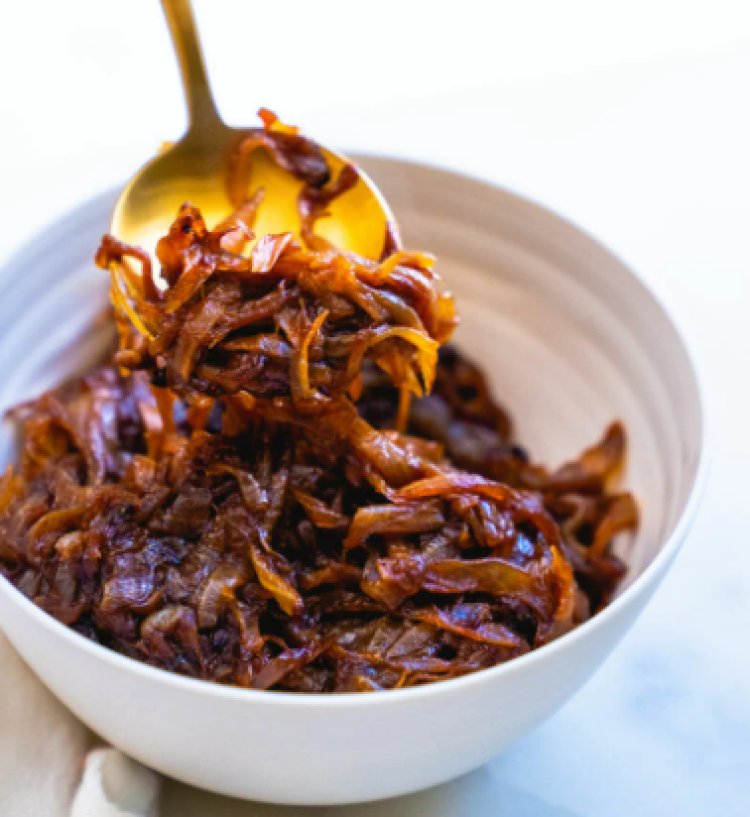How to Perfectly Caramelize Onions
Caramelized onions are cooked low and slow until they are brown, sweet, and incredibly flavorful to be used to soups, salads, burgers, and sandwiches.

Here is a simple, step-by-step guide on how to caramelize onions at home.
It only takes a few ingredients and a little patience to allow the onions to caramelize to perfection, which can take up to an hour. Making caramelized onions is really simple.
Onions must be cooked at a low temperature for a long time in order to draw out the natural sugars that are responsible for caramelization, which takes a lot of time.
Higher heat or attempts to speed the cooking process can cause the moisture to cook out too rapidly, preventing the sugars from being brought out properly, leading to scorched, flavorless onions in the end.
Difference between caramelized and sautéed onions

Sautéed onions rather than caramelized are cooked at a higher temperature, typically between medium-high and high heat, and take 5-8 minutes to complete. On the other hand, caramelized onions take between 45 and 60 minutes to prepare since they are cooked at a lower temperature, which allows the onions to cook slowly and draw out their natural sugars.
Tips for preparing caramelized onions
Any type of onion can be used, however, white onions are most often used for caramelizing onions.
Overcrowding your pan with onions can cause them to steam and release water, making the process to takes more time.
According to some, adding baking soda to the onions while it's cooking alters the pH, which speeds up the reaction and causes the onions to brown more quickly.
If you want extra-dark onions, the kind that are perfect for topping burgers, for a further 10-15 minutes, or until the edges nearly completely blacken.

Ingredients
5 large onions
2 tablespoons olive oil
1 tablespoon butter (optional)
salt
balsamic vinegar/ apple cider (optional)
Procedure
Peel the onions, halve them and slice them to between 1/4 and 1/2 inch thick.
Over medium heat, begin frying the onions in a sizable, heavy-bottomed pan.
Stir in the butter and olive oil to coat the pan's bottom then add the sliced onions and stir to evenly distribute the butter and oil over them.
Continually stir your onions as you let them simmer, as soon as the onions begin to brown, turn the heat down to medium-low.
After about 10 minutes, the onions will begin to soften and turn lightly golden. Add a pinch of salt and toss to mix.
Cook for an additional 30-45 minutes while stirring every 2-3 minutes to prevent the onions from burning.
Keep stirring after 2-3 minutes to allow the onions to fry and brown slightly without burning, and not stick to the bottom of the pan.
The onions won't brown if you stir them too frequently and might burn if you don't stir them frequently enough.
In 30 minutes, your onions should be a beautiful golden hue. Use a metal spoon to remove the browned parts from the pan's bottom.
Continue stirring until your onions get a deep, rich golden brown color, continue to simmer, stir, and scrape the brown pieces off the pan's bottom.
To assist deglaze the pan and give the onions more flavor, you might add a little balsamic vinegar or toward the end of cooking.
Remove from the heat, and serve or transfer to an airtight jar and keep in the fridge for up to four days.

Conclusion
The secret to perfectly caramelized onions is to cook them in a large pan so that the water released as they soften can evaporate more quickly.
Rich onion soups and onion dips can be made with caramelized onions, but they also taste great when heaped high over pizza, burgers, grilled cheese sandwiches, and sausages. They can also be included in salads, grains, rice, and pieces of bread.


























